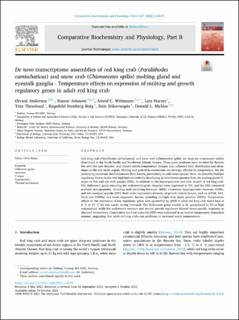| dc.description.abstract | Red king crab (Paralithodes camtschaticus) and snow crab (Chionoecetes opilio) are deep-sea crustaceans widely distributed in the North Pacific and Northwest Atlantic Oceans. These giant predators have invaded the Barents Sea over the past decades, and climate-driven temperature changes may influence their distribution and abundance in the sub-Arctic region. Molting and growth in crustaceans are strongly affected by temperature, but the underlying molecular mechanisms are little known, particularly in cold-water species. Here, we describe multiple regulatory factors in the two high-latitude crabs by developing de novo transcriptomes from the molting gland (Y-organ or YO) and eye stalk ganglia (ESG), in addition to the hepatopancreas and claw muscle of red king crab. The Halloween genes encoding the ecdysteroidogenic enzymes were expressed in YO, and the ESG contained multiple neuropeptides, including molt-inhibiting hormone (MIH), crustacean hyperglycemic hormone (CHH), and ion-transport peptide (ITP). Both crabs expressed a diversity of growth-related factors, such as mTOR, AKT, Rheb and AMPKα, and stress-responsive factors, including multiple heat shock proteins (HSPs). Temperature effects on the expression of key regulatory genes were quantified by qPCR in adult red king crab males kept at 4 °C or 10 °C for two weeks during intermolt. The Halloween genes tended to be upregulated in YO at high temperature, while the ecdysteroid receptor and several growth regulators showed tissue-specific responses to elevated temperature. Constitutive and heat-inducible HSPs were expressed in an inverse temperature-dependent manner, suggesting that adult red king crabs can acclimate to increased water temperatures. | |
